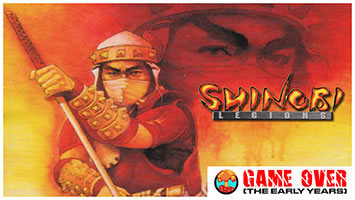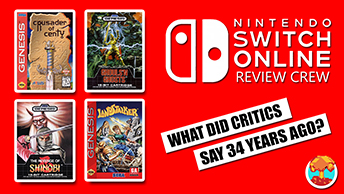- CLASSIC MAGAZINES
- REVIEW CREW
A show recapping what critics thought back
when classic games first came out! - NEXT GENERATION'S BEST & WORST
From the worst 1-star reviews to the best
5-stars can offer, this is Next Generation! - NINTENDO POWER (ARCHIVE)
Experience a variety of shows looking at the
often baffling history of Nintendo Power! - MAGAZINE RETROSPECTIVE
We're looking at the absolutely true history of
some of the most iconic game magazines ever! - SUPER PLAY'S TOP 600
The longest and most ambitious Super NES
countdown on the internet! - THEY SAID WHAT?
Debunking predictions and gossip found
in classic video game magazines! - NEXT GENERATION UNCOVERED
Cyril is back in this spin-off series, featuring the
cover critic review the art of Next Generation! - HARDCORE GAMER MAGAZING (PDF ISSUES)
Download all 36 issues of Hardcore Gamer
Magazine and relive the fun in PDF form!
- REVIEW CREW
- ELECTRONIC GAMING MONTHLY
- ELECTRONIC GAMING MONTHLY RANKS
From Mario to Sonic to Street Fighter, EGM
ranks classic game franchises and consoles! - ELECTRONIC GAMING MONTHLY BEST & WORST
Counting down EGM’s best and worst reviews
going year by year, from 1989 – 2009! - ELECTRONIC GAMING BEST & WORST AWARDS
11-part video series chronicling the ups and
downs of EGM’s Best & Worst Awards!
- ELECTRONIC GAMING MONTHLY RANKS
- GAME HISTORY
- GAME OVER: STORY BREAKDOWNS
Long-running series breaking down game
stories and analyzing their endings! - A BRIEF HISTORY OF GAMING w/ [NAME HERE]
Real history presented in a fun and pithy
format from a variety of game historians! - THE BLACK SHEEP
A series looking back at the black sheep
entries in popular game franchises! - INSTANT EXPERT
Everything you could possibly want to know
about a wide variety of gaming topics! - FREEZE FRAME
When something familiar happens in the games
industry, we're there to take a picture! - I'VE GOT YOUR NUMBER
Learn real video game history through a series
of number-themed episodes, starting at zero! - GREAT MOMENTS IN BAD ACTING
A joyous celebration of some of gaming's
absolute worst voice acting!
- GAME OVER: STORY BREAKDOWNS
- POPULAR SHOWS
- DG NEWS w/ LORNE RISELEY
Newsman Lorne Riseley hosts a regular
series looking at the hottest gaming news! - REVIEW REWIND
Cyril replays a game he reviewed 10+ years
ago to see if he got it right or wrong! - ON-RUNNING FEUDS
Defunct Games' longest-running show, with
editorials, observations and other fun oddities! - DEFUNCT GAMES QUIZ (ARCHIVE)
From online quizzes to game shows, we're
putting your video game knowledge to the test!- QUIZ: ONLINE PASS
Take a weekly quiz to see how well you know
the news and current gaming events! - QUIZ: KNOW THE GAME
One-on-one quiz show where contestants
find out if they actually know classic games! - QUIZ: THE LEADERBOARD
Can you guess the game based on the classic
review? Find out with The Leaderboard!
- QUIZ: ONLINE PASS
- DEFUNCT GAMES VS.
Cyril and the Defunct Games staff isn't afraid
to choose their favorite games and more! - CYRIL READS WORLDS OF POWER
Defunct Games recreates classic game
novelizations through the audio book format!
- DG NEWS w/ LORNE RISELEY
- COMEDY
- GAME EXPECTANCY
How long will your favorite hero live? We crunch
the numbers in this series about dying! - VIDEO GAME ADVICE
Famous game characters answer real personal
advice questions with a humorous slant! - FAKE GAMES: GUERILLA SCRAPBOOK
A long-running series about fake games and
the people who love them (covers included)! - WORST GAME EVER
A contest that attempts to create the worst
video game ever made, complete with covers! - LEVEL 1 STORIES
Literature based on the first stages of some
of your favorite classic video games! - THE COVER CRITIC
One of Defunct Games' earliest shows, Cover
Critic digs up some of the worst box art ever! - COMMERCIAL BREAK
Take a trip through some of the best and
worst video game advertisements of all time! - COMIC BOOK MODS
You've never seen comics like this before.
A curious mix of rewritten video game comics!
- GAME EXPECTANCY
- SERIES ARCHIVE
- NINTENDO SWITCH ONLINE ARCHIVE
A regularly-updated list of every Nintendo
Switch Online release, plus links to review! - PLAYSTATION PLUS CLASSIC ARCHIVE
A comprehensive list of every PlayStation
Plus classic release, including links! - RETRO-BIT PUBLISHING ARCHIVE
A regularly-updated list of every Retro-Bit
game released! - REVIEW MARATHONS w/ ADAM WALLACE
Join critic Adam Wallace as he takes us on a
classic review marathon with different themes!- DEFUNCT GAMES GOLF CLUB
Adam Wallace takes to the links to slice his way
through 72 classic golf game reviews! - 007 IN PIXELS
Adam Wallace takes on the world's greatest spy
as he reviews 15 weeks of James Bond games! - A SALUTE TO VAMPIRES
Adam Wallace is sinking his teeth into a series
covering Castlevania, BloodRayne and more! - CAPCOM'S CURSE
Adam Wallace is celebrating 13 days of Halloween
with a line-up of Capcom's scariest games! - THE FALL OF SUPERMAN
Adam Wallace is a man of steel for playing
some of the absolute worst Superman games! - THE 31 GAMES OF HALLOWEEN
Adam Wallace spends every day of October afraid
as he reviews some of the scariest games ever! - 12 WEEKS OF STAR TREK
Adam Wallace boldly goes where no critic has
gone before in this Star Trek marathon!
- DEFUNCT GAMES GOLF CLUB
- DAYS OF CHRISTMAS (ARCHIVE)
Annual holiday series with themed-episodes
that date all the way back to 2001!- 2015: 30 Ridiculous Retro Rumors
- 2014: 29 Magazines of Christmas
- 2013: 29 Questionable Power-Ups of Christmas
- 2012: 34 Theme Songs of Christmas
- 2011: 32 Game Endings of Christmas
- 2010: 31 Bonus Levels of Christmas
- 2009: 30 Genres of Christmas
- 2008: 29 Controls of Christmas
- 2007: 34 Cliches of Christmas
- 2006: 33 Consoles of Christmas
- 2005: 32 Articles of Christmas
- 2004: 31 Websites of Christmas
- 2003: 29 Issues of Christmas
- 2002: 28 Years of Christmas
- 2001: 33 Days of Christmas
- NINTENDO SWITCH ONLINE ARCHIVE
- REVIEW ARCHIVE
- FULL ARCHIVE
Never Mind the Bollocks Here's the CGE 2K7
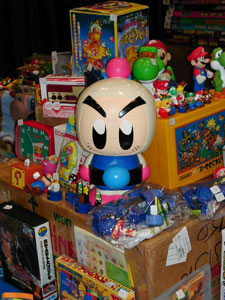
Clearly Nintendo had a better showing at CGE than E3 this year!
The thriving homebrew scene at CGE has always been a dangling carrot that sends many running across the country to snatch up exclusives. Each year, attendees have come to expect packaged homebrews for the 2600, Vectrex, and Intellivision, but this year a NES cartridge captivated a lot of attention: Sudoku, programmed by Al Bailey. While NES homebrews are becoming increasingly common, most of them live solely as ROMS, disembodied from tangible carts. Not only is Sudoku housed in the familiar looking grey chassis, but it comes packaged in a beautiful tin box that will draw one's eye to it in any collector's room - a great deal at only $20. An exclusive gold copy was offered at an
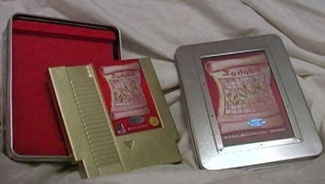
Sure it's just Sudoku, but it's the first brand new NES cartridge in more than a decade ... and it's gold!
Other homebrews lined the tables of Oldergame.com's booth which showcased new 3DO titles like Frog Feast and Decathlon as well as a Saturn collection, Lost & Found 2 - an anthology of unfinished and unreleased titles. Atari2600.com also managed to churn out some new products, and this year unveiled The Last Ninja, N.E.R.D.S., and Rent Wars, a two-player war between competing property owners to furnish their respective apartments.
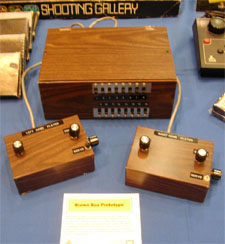
If you've been reading Wes Grogan's wonderful A Brief History of Gaming articles then you should already know what this is!
Away from the synthpop and chatter, was a large room that was eerily quiet, but then I discovered that this was the silence of reverence. This was the museum where hundreds of consoles and their peripherals were arranged according to era or theme. The wonders to behold in this room are too innumerable to be listed here; one could enter and re-enter this room a dozen times and see something missed the first time around. It was hard to miss, however, Ralph Baer's "Brown Box" sitting on the first table. With its chromosome-font labels and faux-wood finish, Baer's machine has always looked like an inauspicious beginning for home gaming, but when surrounded by hundred of other consoles, it sits like the wizened patriarch smoking a pipe on the front porch at a family reunion. Another prototype, the Atari Game Brain, followed leading to a line of other curiosities like the wooden Puppy Pong box, the Adventurevision, a Famicombox from a hotel, and the elusive Atari 2800. If you walked in at the right moment, you could spot Al Alcorn hovering around his Cosmos prototype (a holographic handheld), Glyn Anderson
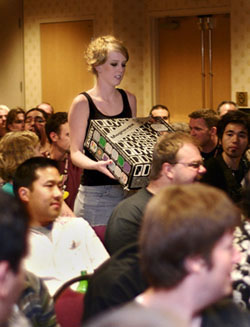
Look everybody ... it's a living, breathing girl!!
As much as collectors and enthusiasts ogle over the hardware, most of them recognize that the biggest rarities at the expo each year are the programmers who put these machines to work. Down the hall from both the main room and museum, several panels met to discuss the intricacies of programming for Atari, Activision, and Intellivision. These informative sessions could have lasted hours, but the moderators did a good job keeping a clock so that questioning did not get too out of hand. After the conferences, all of the panelists were so approachable that conversations tended to leak into the halls and become peripatetic jaunts. With many homebrew programmers in the audience, the discussions tended to be aimed at the tech side of things, but even without a basic understanding BASIC, one can appreciate the complex work needed to create seemingly simple games. In some ways, Atari 2600 games were more tightly scripted than the latest multi-million dollar produced titles. With so little memory space, programmers needed to be inventive to squeeze as much content as possible into their carts. Nowadays, it is strange to hear one talk about the preciousness of memory space. David Crane mentioned how one shortcut in BASIC could free up a scintilla of valuable space on a 4K cartridge. Garry Kitchen talked about how he borrowed the "beep" sound from the Atari's reset button to add one more sound to a maxed-out ROM. In the words of panelist Steve Wright, these guys were "doing a lot with very little." Most second-generation games never credited their programmers with their work, so it's always nice to see them publicly recognized years after their anonymous efforts.
Many of the stories shared at CGE are already well known, but it was a pleasure to hear them directly from their sources. When asked about the fiasco known as the 2600 Pac-Man, the panel jointly gave an almost apologetic justification for its poor quality. They explained that the game was commissioned for the 1982 holiday season giving Todd Frye the unenviable position of finishing it in only six weeks. Crane capped the discussion by quoting Frye: "Why can't ghosts flicker?" It's amazing how 25 years later, people still feel burned by their disappointment.
HOME |
CONTACT |
NOW HIRING |
WHAT IS DEFUNCT GAMES? |
NINTENDO SWITCH ONLINE |
RETRO-BIT PUBLISHING
Retro-Bit |
Switch Planet |
The Halcyon Show |
Same Name, Different Game |
Dragnix |
Press the Buttons
Game Zone Online | Hardcore Gamer | The Dreamcast Junkyard | Video Game Blogger
Dr Strife | Games For Lunch | Mondo Cool Cast | Boxed Pixels | Sega CD Universe | Gaming Trend
Game Zone Online | Hardcore Gamer | The Dreamcast Junkyard | Video Game Blogger
Dr Strife | Games For Lunch | Mondo Cool Cast | Boxed Pixels | Sega CD Universe | Gaming Trend
Copyright © 2001-2024 Defunct Games
All rights reserved. All trademarks are properties of their respective owners.
All rights reserved. All trademarks are properties of their respective owners.














